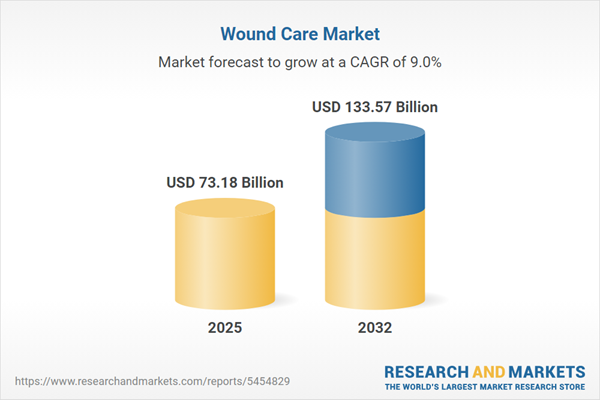Speak directly to the analyst to clarify any post sales queries you may have.
The wound care market is evolving rapidly in response to clinical demands, technological advances, and shifting regulatory standards, driving new approaches in product development and patient management. Leading healthcare executive teams navigating this landscape require actionable insights to inform strategic planning, operational agility, and investment priorities in an increasingly complex environment.
Market Snapshot: Wound Care Market Growth and Outlook
The wound care market grew from USD 67.26 billion in 2024 to USD 73.18 billion in 2025. It is expected to continue growing at a CAGR of 8.95%, reaching USD 133.57 billion by 2032.
Scope & Segmentation
This research delivers a detailed analysis of the wound care sector by dissecting the landscape into critical segments, technologies, and geographies to help senior decision-makers identify targeted growth opportunities.
- Product Types: Dressings (alginate, collagen, film, foam, hydrocolloid, hydrogel), wound care consumables (bandages, gauze, gloves, tapes), wound care equipment (hyperbaric oxygen therapy, negative pressure wound therapy, photodynamic therapy, ultrasound therapy), and wound closure devices (surgical staplers, sutures, tissue adhesives).
- Wound Types: Acute wounds (burn, surgical, traumatic) and chronic wounds (diabetic foot ulcers, pressure ulcers, venous leg ulcers).
- End Users: Ambulatory surgical centers, home care providers, hospitals, long-term care facilities, and specialty clinics.
- Distribution Channels: Direct sales, e-commerce, hospital pharmacies, retail pharmacies.
- Regions: Americas (North America, Latin America), Europe, Middle East & Africa, Asia-Pacific. Geographic granularity includes major countries within each region, supporting precise strategy alignment.
- Companies Profiled: Smith & Nephew plc, Mölnlycke Health Care AB, 3M Company, ConvaTec Group plc, Coloplast A/S, Johnson & Johnson, B. Braun Melsungen AG, Baxter International Inc., Cardinal Health, Inc., and Hollister Incorporated.
Key Takeaways: Critical Insights for Senior Decision-Makers
- Digital health integration is enhancing wound monitoring and enabling remote consultations, supporting targeted, data-driven clinical decisions.
- Technological advances in biomaterials are driving the adoption of advanced dressings and therapies tailored to specific wound profiles and healing needs.
- Value-based models are reshaping procurement criteria, compelling suppliers and providers to demonstrate clear clinical and economic outcomes for their solutions.
- Regulatory adaptation toward streamlined approvals is encouraging the commercialization of innovative wound care technologies while maintaining robust patient safety standards.
- Regional dynamics in reimbursement frameworks, healthcare infrastructure, and epidemiological trends demand locally tailored product strategies and distribution models.
- Strategic collaborations among manufacturers, academic centers, and digital health companies are accelerating R&D and expanding access to next-generation therapies.
Tariff Impact: Navigating New Trade Barriers and Supply Chain Shifts (Wound Care Market)
Recent U.S. tariffs have impacted procurement costs for key wound care materials such as medical-grade polymers and specialty gels. Manufacturers are shifting sourcing and production closer to core markets and seeking alternative materials to manage cost pressures. Procurement teams in hospitals and clinics are recalibrating contracts and leveraging partnerships to mitigate price volatility. Global players are also evaluating manufacturing hubs and free trade zones to offset the impact of new trade measures while staying compliant with evolving regulatory requirements.
Methodology & Data Sources
This report is built on a multi-stage research design combining secondary research from peer-reviewed journals, regulatory filings, and global databases with primary interviews involving clinicians, procurement specialists, and regulatory experts. Market findings were validated through cross-source triangulation and advisory board feedback, ensuring integrity and relevance throughout the research process.
Why This Report Matters for Wound Care Strategy
- Enables high-confidence decision-making with actionable intelligence on technological advances, evolving care standards, and regulatory impacts.
- Guides supply chain and procurement teams in adapting to cost and compliance shifts influenced by tariffs and regional trade landscapes.
- Informs growth planning by mapping segmentation, end user priorities, and competitive initiatives across global regions.
Conclusion
The wound care market’s future will be shaped by the interplay of digital transformation, innovation in materials science, and responsive supply strategies. This research report equips industry leaders with the tools and strategic context needed to secure competitive advantage and drive sustainable growth in a changing healthcare environment.
Additional Product Information:
- Purchase of this report includes 1 year online access with quarterly updates.
- This report can be updated on request. Please contact our Customer Experience team using the Ask a Question widget on our website.
Table of Contents
3. Executive Summary
4. Market Overview
7. Cumulative Impact of Artificial Intelligence 2025
Companies Mentioned
The companies profiled in this Wound Care market report include:- Smith & Nephew plc
- Mölnlycke Health Care AB
- 3M Company
- ConvaTec Group plc
- Coloplast A/S
- Johnson & Johnson
- B. Braun Melsungen AG
- Baxter International Inc.
- Cardinal Health, Inc.
- Hollister Incorporated
Table Information
| Report Attribute | Details |
|---|---|
| No. of Pages | 183 |
| Published | October 2025 |
| Forecast Period | 2025 - 2032 |
| Estimated Market Value ( USD | $ 73.18 Billion |
| Forecasted Market Value ( USD | $ 133.57 Billion |
| Compound Annual Growth Rate | 8.9% |
| Regions Covered | Global |
| No. of Companies Mentioned | 11 |









